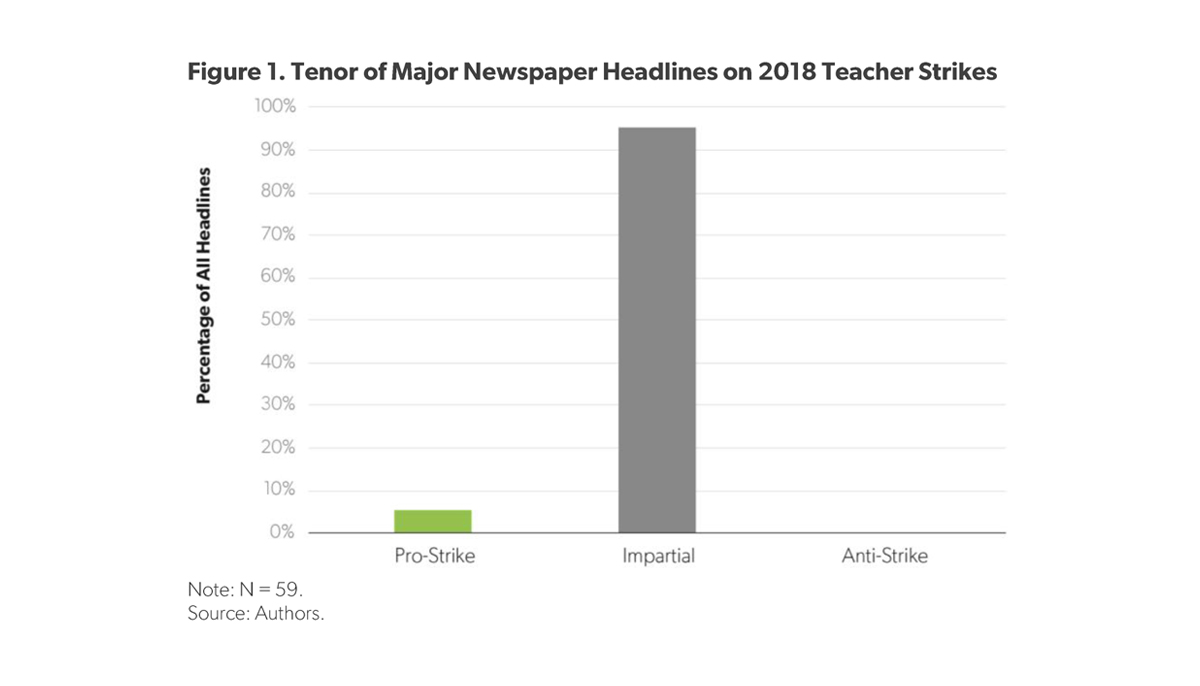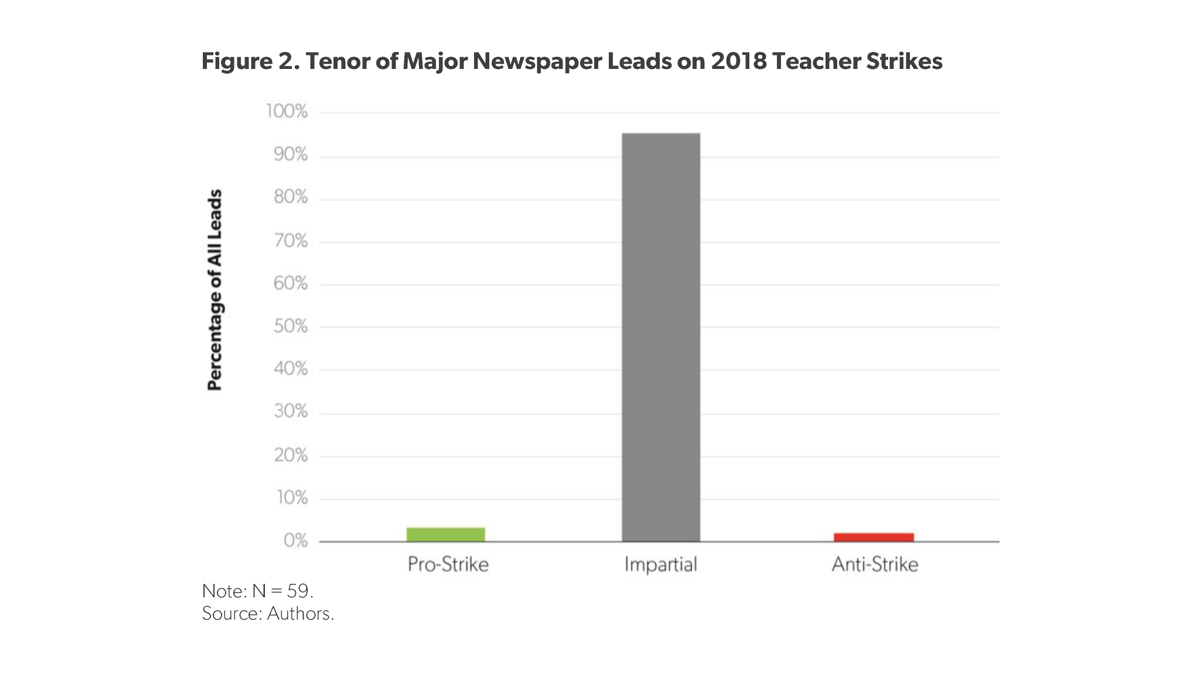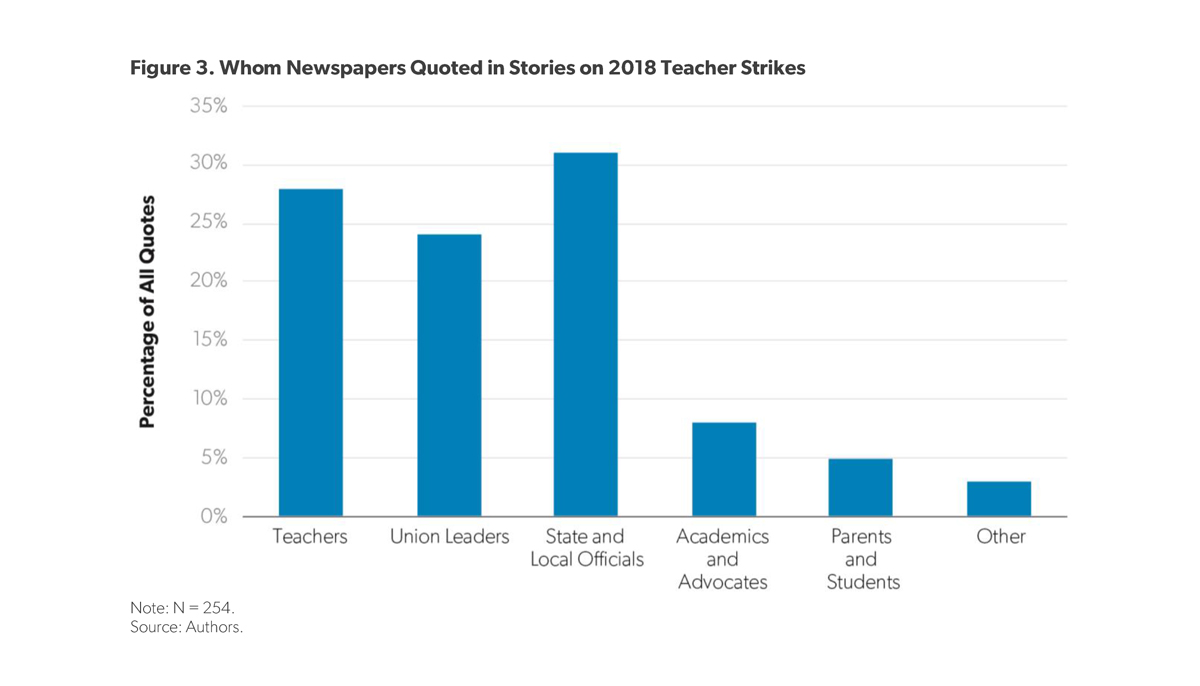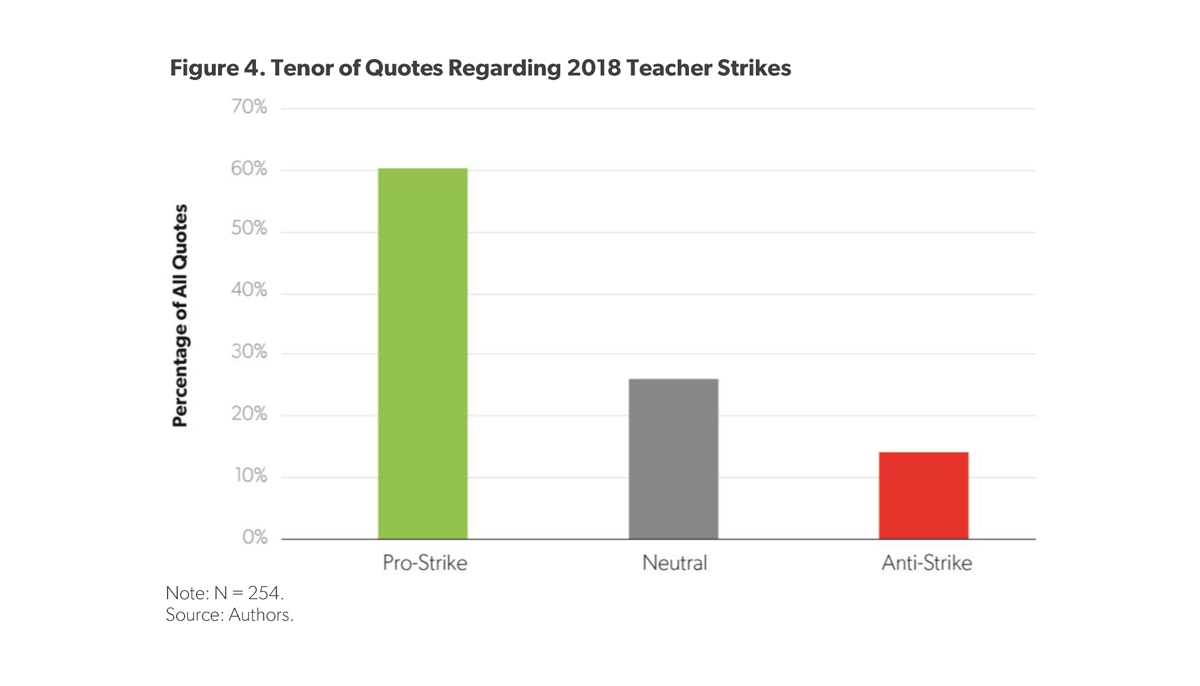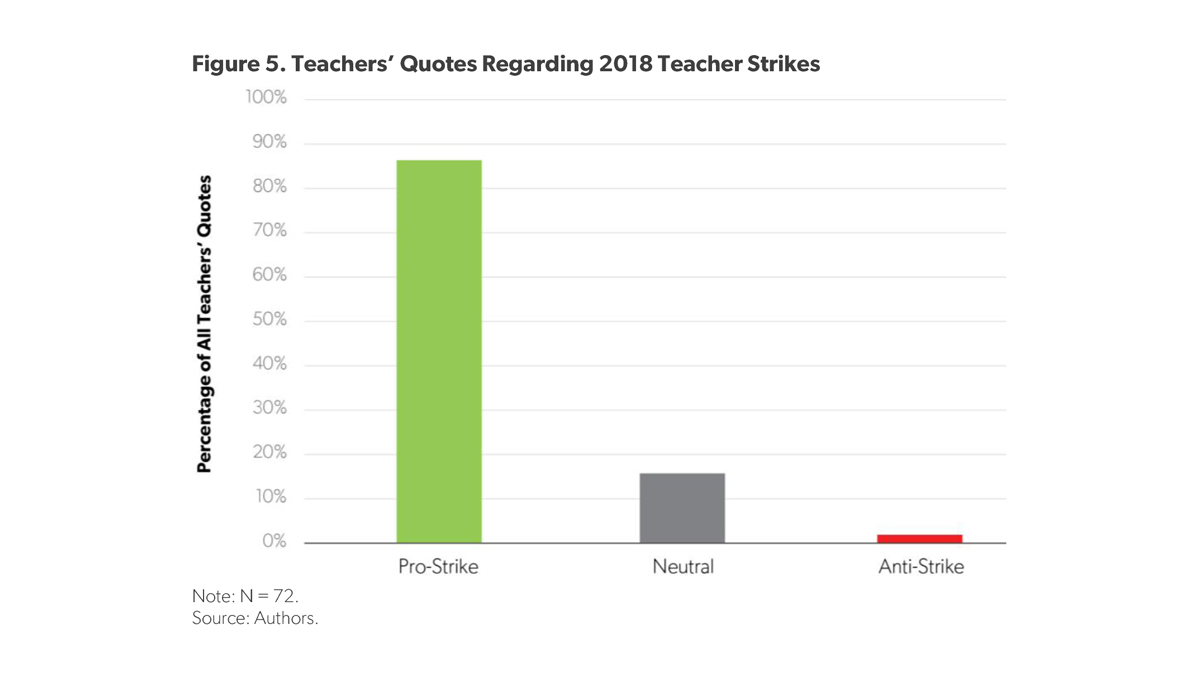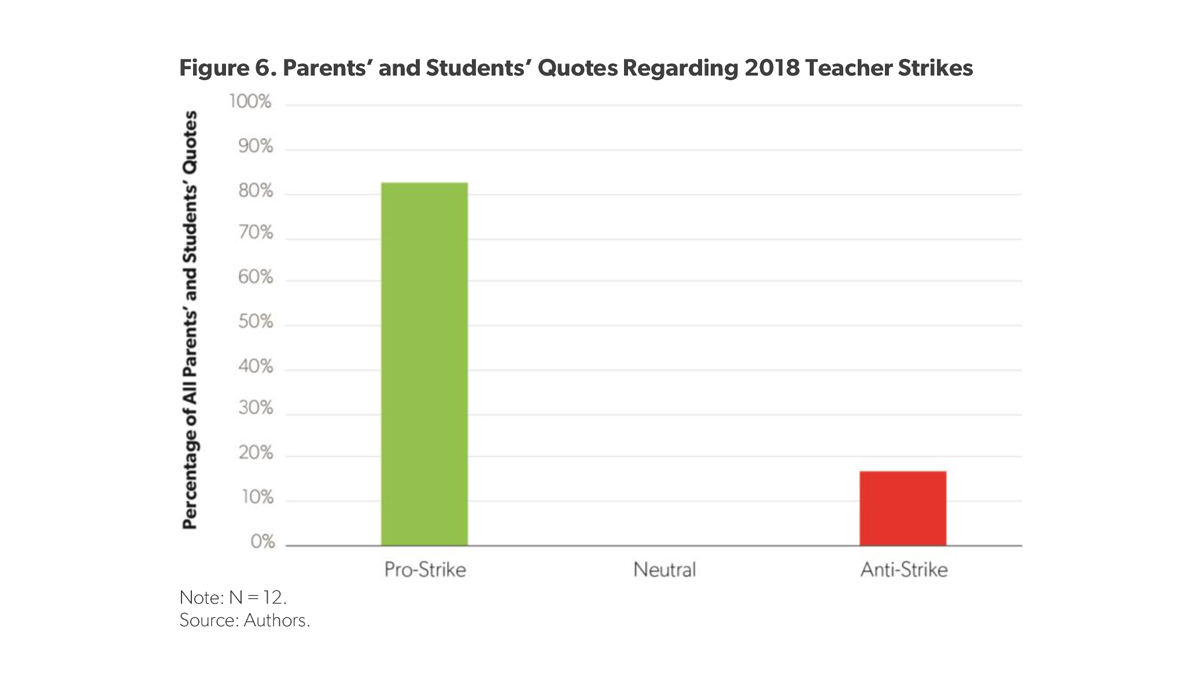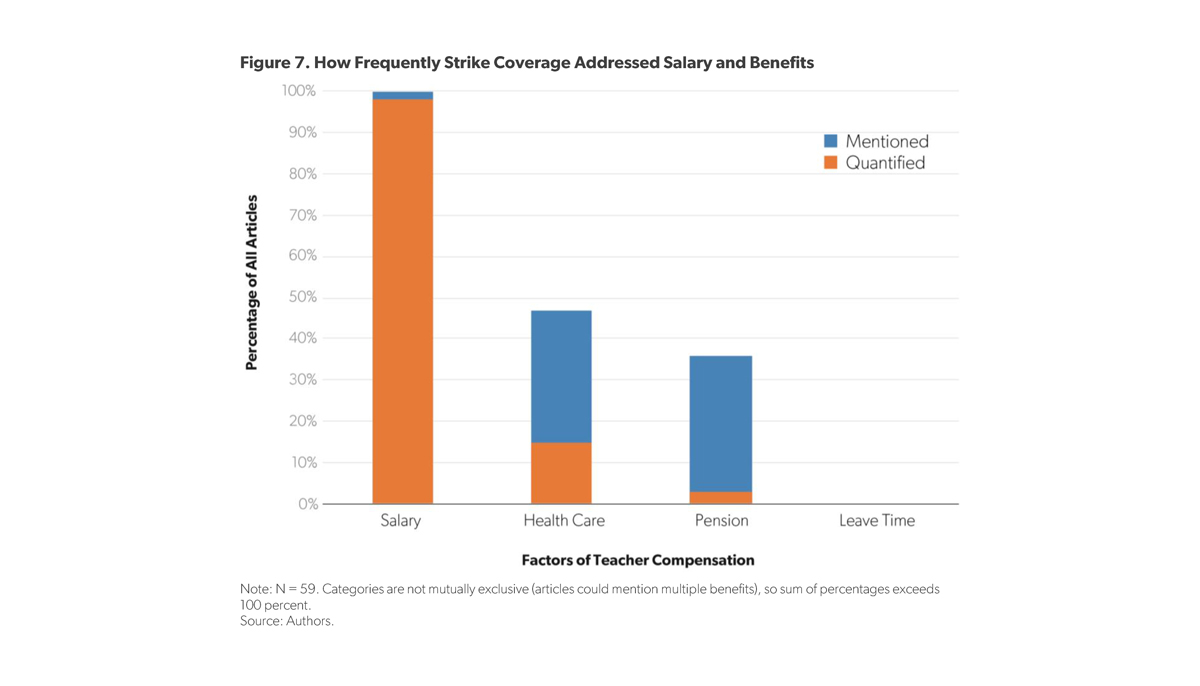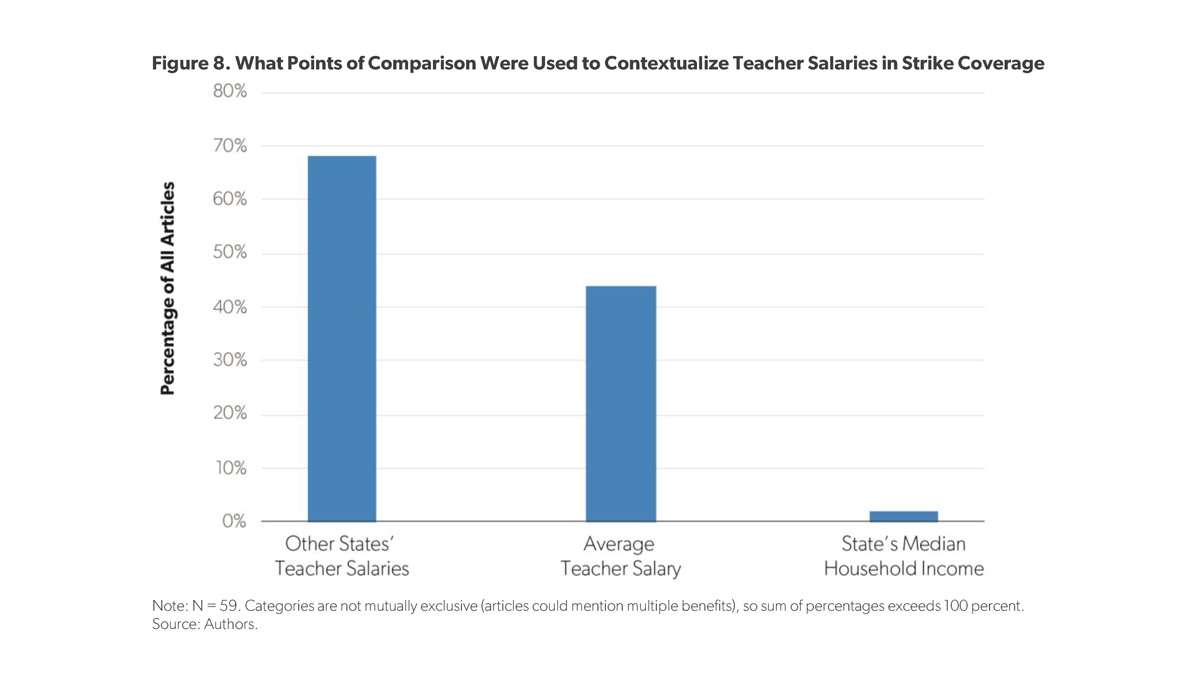Key Points
• This report analyzes every article on the 2018 teacher strikes published by five national newspapers
• The framing of teacher walkout coverage was remarkably impartial, with 56 of 59 article headlines and leads displaying no lean toward one side over another.
• However, articles quoted people in a way that was more one-sided. Over 80 percent of quotes from teachers, parents, and students supported the strikes.
• The coverage often failed to present all the relevant perspectives, such as the thoughts of families affected by the strikes. Of the 254 quotes published, only 5 percent came from an affected parent or student.
• The coverage also neglected to give readers a clear understanding of teacher compensation. Just 15 percent of articles quantified teacher health care benefits, 3 percent quantified pensions, and 2 percent compared teacher salaries to the relevant state’s median household income.
During spring 2018, tens of thousands of teachers in West Virginia, Kentucky, Oklahoma, Arizona, Colorado, and North Carolina walked out of their schools. These teachers were angry about pay, school funding, proposed benefit changes, and more. The walkouts attracted extensive media attention across the land; that coverage has helped shape public understanding of the strikes and any political impact. With that in mind, this report examines how five national newspapers (the New York Times, Wall Street Journal, Washington Post, Los Angeles Times, and USA Today) covered the strikes.
Specifically, we examined how stories about the strikes were framed, who was quoted in those stories, and what information about teacher compensation was provided to readers. Using the search engine LexisNexis (a database that collects news articles from national and international news outlets), we identified all the stories these newspapers published on the walkouts between February 15 (just before the first walkout in West Virginia) and June 1 (after the last major walkout ended in May).
In all, we examined 59 news stories. The New York Times published 17 articles on the walkouts; the Wall Street Journal, 16; the Washington Post, 13; the Los Angeles Times, 10; and USA Today, 3. Twenty-six of the articles focused specifically on the West Virginia walkout, 11 on Oklahoma, 5 on Arizona, and the rest on less-prominent walkouts or on multiple states.
How Were News Stories Framed?
Headlines and lead paragraphs are important in determining the tenor of news coverage. Consequently, we analyzed whether the headlines and leads (the first three paragraphs) of each article endorsed or rejected the strikers’ position.
Of the 59 headlines on the walkouts, 56 displayed no tilt toward either the strikers or their critics, as illustrated in Figure 1. For example, an impartial February 22 Wall Street Journal story simply stated, “West Virginia Teachers Go on Statewide Strike.” [1]
Using the same approach, we analyzed the articles’ leads. As shown in Figure 2, 56 of 59 leads showed no partiality, closely mirroring the tenor of the headlines. For instance, one impartial February 27 New York Times story began, “A teachers’ strike that ground public schools to a halt across West Virginia is set to end on Thursday, a week after it began.” [2]
In sum, major newspapers were remarkably impartial when framing stories on the 2018 teacher strikes. Therefore, it is well worth examining what else we can learn about media coverage of the walkouts.
Did the Coverage Favor Some Voices over Others?
When journalists write articles about something like the teacher strikes, a considerable part of the story is which voices are heard. That means it matters greatly whom they interview and then whom they quote.
After all, reporters had an array of parties and perspectives they could quote while covering the walkouts. There were teachers who wanted higher pay. There were small-government advocates concerned about the cost of tax increases. There were parents who had to make day care arrangements for their children because the walkouts closed their schools. There were union leaders who strongly endorsed the strikes. Given the many voices involved, which ones were more evident in the coverage?
To address this question, we tallied all quotes attributed by name in the 59 articles, identifying 170 individuals who were quoted 254 times. (The numbers do not match because some individuals were quoted on multiple occasions.)
Who Was Quoted? Those quoted in the stories fell into five major categories: teachers, union leaders, state and local officials, academics and advocates, and parents and students.
As Figure 3 displays, teachers supplied about 28 percent of the 254 quotes published, union leaders 24 percent, and state and local officials 31 percent. Notably, parents and students affected by the walkouts provided just 5 percent of the quotes. [3]
What Was Said? Perhaps as important as who is quoted is what they are quoted as saying. On that score, we tallied how many of the 254 quotes supported the walkouts, how many were critical, and how many took no position. [4]
In one example of a pro-strike quotation, Noah Karvelis (an organizer of the Arizona strike) was quoted as saying, “If we maintain the status quo, that is way worse than missing a couple of days of school. The biggest disservice any of us could do for our students right now is to not act in this moment.” [5] On the other hand, in a representative anti-strike quotation, Jim Segar (an Arizona physical education teacher) was quoted as saying, “You can’t get everything at once after years of neglect. I think people would be crazy to walk out or strike now.” [6]
As Figure 4 shows, 60 percent of the quotes were pro-strike, roughly a quarter were neutral, and 14 percent were negative.
The pro-strike/anti-strike balance of quotes across the key stakeholder groups is of interest. Among union leaders, more than 80 percent of the quotes were pro-strike, and none were critical of the walkouts. The quotes of government officials were mixed, with 24 percent pro-strike, 43 percent neutral, and 32 percent anti-strike. Among academics and advocates, just 10 percent of the quotes were pro-strike, while two-thirds were neutral and 24 percent negative.
The articles examined had 72 quotes from teachers. As Figure 5 depicts, the teachers’ quotes were almost uniformly pro-strike, with 86 percent of them in favor and just 1 percent opposed.
As noted earlier, parents and students were seldom quoted; they contributed only 12 of the 254 quotes. Of those dozen quotes, the vast majority were pro-strike, while just two were negative (Figure 6).
How Much Context Was Included When Depicting Teacher Compensation?
The issues surrounding the teacher walkouts were complex. Given that strong claims about school spending, work conditions, and teacher pay were at the heart of the strikes, reporters routinely sought to provide needed context. The question is whether the coverage gave readers the whole picture of teacher compensation. After all, salary is the most significant component of teacher compensation, but it is accompanied by several other significant, costly employment benefits.
Which Kinds of Compensation Were Included in the Coverage? We tallied the number of articles that mentioned four different components of teacher compensation: salary, health care benefits, pension benefits, and leave time (including a shorter-than-average work year).
Figure 7 displays how the coverage addressed these four components, in terms of whether each was mentioned (the blue bars) or quantified (the orange bars). Of course, mentions of a benefit include (but are not limited to) instances in which that benefit was quantified.
A story was deemed to have mentioned a benefit if even a single sentence alluded to it (which means the results inevitably overestimate the amount of meaningful context provided). For instance, we counted an April 20 Wall Street Journal story as having mentioned pensions because it included the single line, “Strikes have cropped up in states where teacher salaries have fallen most sharply since the 2008–2009 recession, prompted in part by a revenue squeeze as states are forced to spend more on health-care and retirement programs.” [7] The blue bars in Figure 7 show that every story mentioned teacher salaries but that less than half mentioned health care benefits, barely a third mentioned pension plans, and none mentioned leave time.
To get a more substantive sense of how much context stories provided, we also examined how many articles attempted to quantify the value of the benefit in question. The orange bars in Figure 7 denote the percentages of articles that offered some sense of the amounts involved. For example, an April 2 New York Times story sought to quantify the salary figure in question, reporting, “Last week, the Legislature in Oklahoma City voted to provide teachers with an average raise of $6,000 per year, or roughly a 16 percent raise, depending on experience.” [8]
As Figure 7 shows, 98 percent of articles quantified the value of teacher salaries. Yet the coverage rarely conveyed the value of other benefits. Just 15 percent of articles quantified the value of teacher health benefits, and barely 3 percent sought to give a sense of teacher pension value. Meanwhile, no story tried to quantify the amount or value of teacher professional leave or teachers’ shorter-than-average work year.
How Did Stories Help Make Sense of Teacher Pay? While the coverage rarely referenced benefits, it always mentioned teacher salaries. Given that, we looked at how often the coverage used various comparisons to help readers make sense of the many claims regarding teacher pay.
News coverage routinely compared teacher salaries to those in other states, typically by noting where a given state ranked nationally in terms of pay (Figure 8). More than two-thirds of articles included that kind of comparison. At the same time, less than half the articles actually provided the relevant state’s average teacher salary. And only 2 percent of articles noted how a state’s average teacher salary compared to that state’s median household income.
Takeaways
In this report, we seek to better understand how major newspapers covered the 2018 teacher strikes. A close look suggests, generally speaking, that the press did an admirable job of framing its coverage impartially, tended to emphasize pro-strike voices, and could have done a vastly better job providing important contextual information that could help readers make sense of the strikes. Five takeaways in particular deserve elaboration.
First, the framing of walkout coverage was remarkably impartial. In almost no case did either the headlines or the leads of articles overtly favor one side in the disputes. This is heartening to see, given concerns about whether the media can report objectively on contentious issues.
Second, the coverage hardly ever quoted parents and students affected by the strikes. Of 254 total quotes published, fewer than 5 percent came from an affected parent or student. In fact, just 14 percent of the stories covering the walkouts featured a single quote from an affected parent or student.
This omission is striking because families were the largest group impacted by the walkouts—in Arizona alone, over 800,000 students were affected—and bore the brunt of the disruptions. [9] Whatever families thought of the strikes, positive or negative, was obviously important. Yet, while families were a huge part of the story, one could read extensively about the strikes and never hear their perspective.
Third, the quotes exhibited a seemingly pro-strike tilt. While 60 percent of all quotes supported the strikes and just 14 percent were anti-strike, opinion appears to have been more mixed than this ratio suggests. For instance, more than 80 percent of the parents and students quoted were pro-strike, but a 2018 Education Next poll showed that 53 percent of the general public supported teachers’ right to strike—and one-third rejected it. Public opinion toward the strikes was positive—but much less so than the coverage seemed to suggest [10]
Similarly, while 86 percent of teachers’ quotes were pro-strike, that figure also appears high. Indeed, even the pro-strike Arizona Educators United claimed that only 78 percent of Arizona teachers were pro-strike. [11] Setting aside the strike question, only 76 percent of teachers nationwide think teacher pay should be higher. [12] Again, that is quite supportive, but less so than the quotes indicated—and this is just on the general question of pay, not the more contentious question of whether a given strike or walkout is a good idea.
In other words, it appears that the selection of sources denied readers the chance to more fully understand anti-strike perspectives.
Fourth, the coverage generally did a poor job addressing the non-salary components of teacher compensation. After all, while 98 percent of articles referenced the value of teacher salaries, salary is not the whole of teacher compensation. The generosity of teacher health care benefits and pensions is a major issue in discussions of school spending and teacher pay.
Yet, less than half the articles even mentioned health care benefits, and barely a third mentioned pensions. Just 3 percent of stories obliquely referenced the value of teacher pensions, and not a single one mentioned teacher vacation time or the length of the teacher work year. The point is not that such information points a particular direction on teacher pay but that it is essential to help readers reach their own judgments about the merits of teacher demands.
Finally, the coverage almost uniformly failed to help readers reach their own conclusions about the state of teacher pay—the central issue of the teacher walkouts. Half the stories did not even include the pertinent average teacher salary. Meanwhile, just 2 percent of articles compared teacher pay to the state’s median household income. Especially in financially stressed states, it was potentially relevant that, in some cases, the average teacher was already earning more than the state’s median household. [13] At the least, readers benefit from having some sense of how teacher pay compares to the income of the households that would fund any boost in their pay.
After all, while a 2018 Education Next poll reported that two-thirds of the public supports higher pay for teachers, that figure falls to 49 percent when respondents are informed how much teachers in their state already earn. [14] Regardless of where one stands on teacher pay increases, this kind of information is clearly relevant to public deliberation.
Newspapers deserve commendation for their impartial framing of the stories. At the same time, the selection of quotes raised some grounds for concern, and a remarkable lack of information about teacher compensation meant that stories lacked crucial context. In the end, these flaws appear to have injected a subtle but important pro-strike bias into the coverage. But with the possibility of more strikes looming, the press should have plenty of opportunities to do better.
Frederick M. Hess is the director of education policy studies and a resident scholar at AEI. RJ Martin is a research assistant in education policy studies at AEI.
Appendix A. Examples of Coding Methodology
The following tables contain examples illustrating how the headlines, leads, quotes, and information from news articles were coded in the analysis.
| Pro-Strike | Impartial | Anti-Strike |
Table A1. Examples of Article Headlines with a Pro-Strike, Impartial, or Anti-Strike Tenor
| Source (Author, Publisher, Date, and URL) |
Article Headline |
| Alia E. Dastagir, USA Today, March 8, 2018, https://www.usatoday.com/story/news/2018/03/08/west-virginia-teachers-victory-shows-power-women-more-battles-loom/403374002/. | “West Virginia Teachers’ Victory Shows ‘Power of Women’ as More Battles Loom”
|
| Matt Pearce, Los Angeles Times, March 6, 2018, http://www.latimes.com/nation/la-na-teacher-funding-20180306-story.html. | “West Virginia Teachers Win 5% Pay Raise as Massive Strike Comes to an End” |
| Tawnell D. Hobbs and Michelle Hackman, Wall Street Journal, April 30, 2018, https://www.wsj.com/articles/when-teachers-strike-parents-face-dilemma-1525080600. | “When Teachers Strike, Parents Face Dilemma” |
Source: Authors.
Table A2. Examples of Article Leads with a Pro-Strike, Impartial, or Anti-Strike Tenor
| Source (Author, Headline, Publisher, Date, and URL) |
Lead and Framing |
| Alia E. Dastagir, “West Virginia Teachers’ Victory Shows ‘Power of Women’ as More Battles Loom,” USA Today, March 8, 2018, https://www.usatoday.com/story/news/2018/03/08/west-virginia-teachers-victory-shows-power-women-more-battles-loom/403374002/. | “For nearly two weeks, teachers in West Virginia refused to go to work. They held massive rallies at the capitol almost daily, protesting low pay and rising health care costs. On the strike’s ninth day, Gov. Jim Justice announced a deal to give all state employees a 5% raise and halt raising health insurance premiums. When it was over many teachers—exhausted, overjoyed and eager, they said, to get back to their students—wept. The strike in West Virginia shows more than the power of collective organizing—it shows the power of women, political scientists and labor experts say.” |
| Kris Maher, “Teacher Walkouts to Close West Virginia Schools in Some Counties,” Wall Street Journal, February 15, 2018, https://www.wsj.com/articles/teacher-walkouts-to-close-west-virginia-schools-in-some-counties-1518716996. | “Schools in at least six West Virginia counties said they would cancel classes Friday, as teachers at those schools plan to walk out over pay and benefits. The school closings would affect 32,000 students, according to figures from the state Education Department.” |
Note: There were no leads with an anti-strike tenor.
Source: Authors.
Table A3. Examples of quotes from Articles with a Pro-Strike, Impartial, or Anti-Strike Tenor
| Source (Author, Headline, Publisher, Date, and URL) |
Quotation |
| Simon Romero, Jack Healy, and Julie Turkewitz, “Teachers in Arizona and Colorado Walk Out over Education Funding,” New York Times, April 26, 2018, https://www.nytimes.com/2018/04/26/us/teacher-walkout-arizona-colorado.html. | “A teaching certification used to secure landing in the middle class,” Mr. Thomas added. “That’s not the case anymore in Arizona, and we need to do something about it now.” |
| Michelle Hackman, “Arizona Teachers Vote to Go on Strike,” Wall Street Journal, April 21, 2018, https://www.wsj.com/articles/arizona-teachers-vote-to-go-on-strike-1524227874. | “Weak unions tend to produce strikes,” said Paul Peterson, director of the education policy and governance program at the Harvard Kennedy School. |
| Michelle Hackman, “Why Teachers’ Strikes Are Becoming a Nationwide Movement,” Wall Street Journal, April 1, 2018, https://www.wsj.com/articles/why-teachers-strikes-are-becoming-a-nationwide-movement-1522584001. | “A strike is hugely disruptive to families and kids,” said Dan Weisberg, CEO of TNTP, a nonprofit group promoting teacher quality. “This is high stakes, and it’s of particular risk in low-wage states.” |
Source: Authors.
Table A4. Examples of an Article Mentioning Teacher Benefits
| Type of Benefit | Source (Author, Headline, Publisher, Date, and URL) |
Quotation |
| Salary | Matt Pearce, “Around the U.S., Protesting Teachers See Some Gains in Conservative States,” Los Angeles Times, April 15, 2018, http://www.latimes.com/nation/la-na-teachers-strikes-20180416-story.html . | “Teachers, demanding $10,000 in raises, have gone on strike for nine days. The Republican-controlled state legislature, in response, approved $6,000 in raises, passing the first tax hikes by the legislature since 1992. But further gains have been elusive.” |
| Health Care | John Bacon, “West Virginia Teacher Strike Ends, Some Schools to Reopen Wednesday,” USA Today, March 6, 2018, https://http://www.usatoday.com/story/news/nation/2018/03/06/tentative-deal-reached-end-west-virginia-teacher-strike-governor-says/398850002/ . | “West Virginia teachers are among the lowest paid in the nation and went years without a raise. Randi Weingarten, AFT national president, said the state’s teachers had been saddled with shrinking salaries because of fast-rising health care costs.” |
| Pensions | Michelle Hackman, “Why Teachers’ Strikes Are Becoming a Nationwide Movement,” Wall Street Journal, April 1, 2018, https://www.wsj.com/articles/why-teachers-strikes-are-becoming-a-nationwide-movement-1522584001. | “Kentucky teachers also plan to protest in the state capital on Monday against a pension bill rapidly passed through the legislature last week that shifts future teachers into a hybrid between a traditional pension and a 401(k) plan. And unions in Arizona and North Carolina are taking steps toward possible actions over pay and benefits.” |
Source: Authors.
Appendix B. List of Articles Analyzed
We searched LexisNexis in May–June 2018 for news articles (excluding blog posts and op-eds) specifically focused on the 2018 teacher strikes, published between February 15 and June 1. We searched using keywords such as “teacher,” “strike,” and “walkout” and various combinations of those keywords.
Note that article headlines and publication dates from LexisNexis reflect the print versions of the article and may vary from online versions of the article.
LexisNexis only includes abstracts of Wall Street Journal articles. So to ensure that we had a comprehensive collection of articles, we also searched (using the same criteria as described above) directly on the Journal’s website.
| Source | Article Title | Date |
| Los Angeles Times | Healthcare Drives Teachers to Strike in West Virginia | March 3, 2018 |
| Los Angeles Times | West Virginia Teachers Reject Lawmakers’ Raise; Strike to Go on After State Senate OKs a 4% Increase Instead of the 5% That Was Agreed on | March 4, 2018 |
| Los Angeles Times | Oklahoma Teachers Ready to Strike; Statewide Action Would Follow West Virginia’s. Parents and Districts Support Them. | March 6, 2018 |
| Los Angeles Times | West Virginia Teachers’ Strike Ends; Lawmakers Approve a 5% Pay Increase After a Nine-Day Statewide Walkout | March 7, 2018 |
| Los Angeles Times | Oklahoma Teachers Ready to Walk; Following Success of West Virginia Action, Educators Rise Up to Override Union with a Plan to Strike April 2 | March 10, 2018 |
| Los Angeles Times | Sickout Closes Kentucky Districts | March 31, 2018 |
| Los Angeles Times | Bosses Get Behind Teachers’ Strike Plan in Oklahoma; Superintendents and School Boards Around the State Join Push to Get Lawmakers to Back Significant Pay Raises | March 31, 2018 |
| Los Angeles Times | Schoolteachers ‘Not Gonna Take It’; Educators Go on Strike in Oklahoma and Protest in Kentucky for Pay Increases and Pension Protections | April 3, 2018 |
| Los Angeles Times | Lawmakers in Red States Get Schooled by Teachers; Protests over Low Pay, Strained Education Budgets Have Gotten Results | April 16, 2018 |
| Los Angeles Times | Statewide Teacher Strikes Head West; Walkouts in Colorado and Arizona Continue the Nationwide Debate on Education Funding | April 28, 2018 |
| USA Today | W.Va. Teachers Back on Job After 5% Raise Demand Is Met; Students Could Return to Class as Early as Today |
March 7, 2018 |
| USA Today | W.Va. Teachers Show Power of Women; Strikers Say Men in Power Disrespected Them | March 9, 2018 |
| USA Today | Tired of Begging, Teachers Shut Schools in Okla., Ky | April 3, 2018 |
| New York Times | West Virginia Teachers Walk Out over Pay | February 24, 2018 |
| New York Times | Thousands of West Virginia Teachers Strike for a Second Day | February 24, 2018 |
| New York Times | West Virginia Teachers’ Strike Ends with a Promise to Raise Pay | March 1, 2018 |
| New York Times | West Virginia Teacher Strike Enters Its Seventh Day | March 4, 2018 |
| New York Times | West Virginia’s Teachers Get Pay Raise to End Statewide Strike | March 7, 2018 |
| New York Times | ‘All-In or Nothing’: West Virginia’s Teacher Strike Was Months in the Making | March 7, 2018 |
| New York Times | Striking Teachers Defied West Virginia, and Their Own Union, Too | March 9, 2018 |
| New York Times | Fed Up, Teachers in Oklahoma May Walk Next | March 21, 2018 |
| New York Times | Teacher Walkouts: What to Know and What to Expect | April 2, 2018 |
| New York Times | Teachers Walk Out in 2 States as Fervor Spreads | April 3, 2018 |
| New York Times | Oklahoma Teachers End Walkout After Winning Raises and Additional Funding |
April 12, 2018 |
| New York Times | Kentucky Lawmakers Override Budget Veto in Win for Teachers | April 13, 2018 |
| New York Times | Teacher Walkouts Threaten Republicans’ Grip on Red States | April 13, 2018 |
| New York Times | In Protest of Low Pay, Educators in Arizona Threaten to Walk Out | April 21, 2018 |
| New York Times | Wave of Red Surges into Arizona and Colorado | April 27, 2018 |
| New York Times | Walkout Ends as Arizona Gives Raises to Teachers | May 4, 2018 |
| New York Times | North Carolina Teachers Join Walkout Movement | May 17, 2018 |
| Washington Post | West Virginia Teachers Stage Walkout, and Schools Close | February 23, 2018 |
| Washington Post | W.Va. Teacher Strike Is Likely to Continue Monday | February 25, 2018 |
| Washington Post | W.Va. Teacher Strike Expected to Enter Fourth Day | February 27, 2018 |
| Washington Post | W.Va. Teachers Expected to Return to Classes as Governor Announces a Deal |
February 28, 2018 |
| Washington Post | W.Va. Teacher Strike Highlights State Poverty | March 1, 2018 |
| Washington Post | W.Va. Teacher Strike May Continue Friday Despite Agreement | March 2, 2018 |
| Washington Post | In W.Va., a Deal with Teachers Ends 9-Day Strike | March 7, 2018 |
| Washington Post | Teachers in Oklahoma Threaten to Strike | April 1, 2018 |
| Washington Post | Fed Up with School Spending Cuts, Oklahoma Teachers Walk Out | April 3, 2018 |
| Washington Post | Okla. Governor’s Slam Vexes Teachers | April 5, 2018 |
| Washington Post | Okla. Teachers End Walkout but Will Keep Fighting | April 15, 2018 |
| Washington Post | Arizona, Colorado Teachers Are the Latest to Walk Out over Education Funding |
April 27, 2018 |
| Washington Post | Ariz. Teachers End Walkout After Getting Promise of Raises, Increased Funding |
May 4, 2018 |
| Wall Street Journal | Teacher Walkouts to Close West Virginia Schools in Some Counties | February 15, 2018 |
| Wall Street Journal | West Virginia Teachers Go on Statewide Strike | February 22, 2018 |
| Wall Street Journal | Public School Teachers in West Virginia End Strike | February 27, 2018 |
| Wall Street Journal | Q&A: West Virginia Sees Rare Statewide Teacher Walkout | February 27, 2018 |
| Wall Street Journal | West Virginia Teachers Remain on Strike Despite Tentative Deal | March 1, 2018 |
| Wall Street Journal | West Virginia Teachers Strike Ends with 5% Pay Raise | March 6, 2018 |
| Wall Street Journal | Teacher Unions See Momentum Build with West Virginia Strike | March 7, 2018 |
| Wall Street Journal | Why More States Are Tussling with Their Teachers | March 18, 2018 |
| Wall Street Journal | Why Teachers’ Strikes Are Becoming a Nationwide Movement | April 1, 2018 |
| Wall Street Journal | Oklahoma Teachers Continue Walkout | April 3, 2018 |
| Wall Street Journal | Oklahoma Teachers Declare End to Nine-Day Strike | April 12, 2018 |
| Wall Street Journal | Kentucky Lawmakers Override Governor Veto on Tax, Budget Bills | April 13, 2018 |
| Wall Street Journal | Arizona Teachers Vote to Go on Strike | April 20, 2018 |
| Wall Street Journal | The New Test for Cash-Strapped U.S. States: Teacher Protests | April 22, 2018 |
| Wall Street Journal | When Teachers Strike, Parents Face Dilemma | April 30, 2018 |
| Wall Street Journal | Arizona Teachers Gain 20% Pay Raise, Expected to Return to Work | May 3, 2018 |
Notes:
1. Kris Maher, “West Virginia Teachers Go on Statewide Strike,” Wall Street Journal, February 22, 2018, https://www.wsj.com/ articles/west-virginia-teachers-go-on-statewide-strike-1519309185.
2. Jess Bidgood, “West Virginia Teachers’ Strike Ends with a Promise to Raise Pay,” New York Times, February 27, 2018, https:// www.nytimes.com/2018/02/27/us/west-virginia-teachers-strike-ends.html.
3. The “parents and students” included in this category were not also on teaching staff, a union leader, a government official, or an academic or advocate.
4. A quotation was scored as “pro-strike” if it contained an explicit endorsement of the strikes, supported the strikes’ goals, or was cited as a justification for the strikes. A quotation was scored as “anti-strike” if it explicitly condemned the strikes, criticized the strikes’ goals, or was cited as an argument against the strikes.
5. Dana Goldstein, “Arizona Teachers Vote in Favor of Statewide Walkout,” New York Times, April 20, 2018, https://www. nytimes.com/2018/04/20/us/arizona-teacher-walkout.html.
6. Goldstein, “Arizona Teachers Vote in Favor of Statewide Walkout.”
7. Michelle Hackman, “Arizona Teachers Vote to Go on Strike,” Wall Street Journal, April 20, 2018, https://www.wsj.com/ articles/arizona-teachers-vote-to-go-on-strike-1524227874.
8. Dana Goldstein, “Teachers in Oklahoma and Kentucky Walk Out: ‘It Really Is a Wildfire,’” New York Times, April 2, 2018, https://www.nytimes.com/2018/04/02/us/teacher-strikes-oklahoma-kentucky.html.
9. Tawnell D. Hobbs and Michelle Hackman, “When Teachers Strike, Parents Face Dilemma,” Wall Street Journal, April 30, 2018, https://www.wsj.com/articles/when-teachers-strike-parents-face-dilemma-1525080600.
10. Albert Cheng et al., “Public Support Climbs for Teacher Pay, School Expenditures, Charter Schools, and Universal Vouchers,” Education Next 19, no. 1 (Winter 2019), https://www.educationnext.org/public-support-climbs-teacher-pay-school-expenditures-charter-schools-universal-vouchers-2018-ednext-poll/.
11. Jonah Furman, “Massive Crowds Flood Capital as Arizona Teachers Stage First-Ever Statewide Walkout,” Labor Notes, April 27, 2018, http://labornotes.org/2018/04/massive-crowds-flood-capital-arizona-teachers-stage-first-ever-statewide-walkout.
12. Cheng et al., “Public Support Climbs for Teacher Pay, School Expenditures, Charter Schools, and Universal Vouchers.”
13. National Education Association, Rankings of the States 2017 and Estimates of School Statistics 2018, April 2018, http://www. nea.org/assets/docs/180413-Rankings_And_Estimates_Report_2018.pdf; and Gloria G. Guzman, “Household Income: 2016,” US Census Bureau, September 2017, https://www.census.gov/content/dam/Census/library/publications/2017/acs/acsbr16-02.pdf.
14. Cheng et al., “Public Support Climbs for Teacher Pay, School Expenditures, Charter Schools, and Universal Vouchers.”


